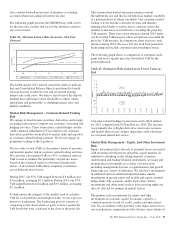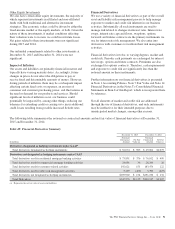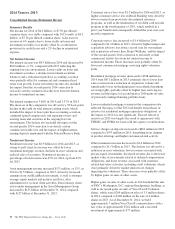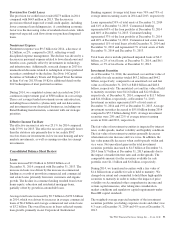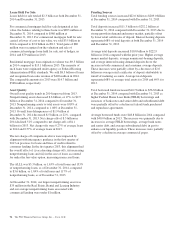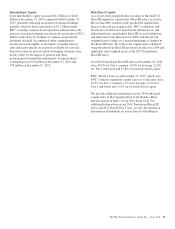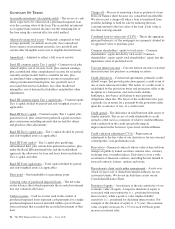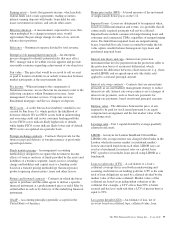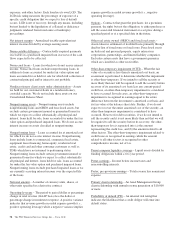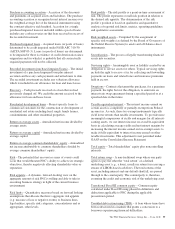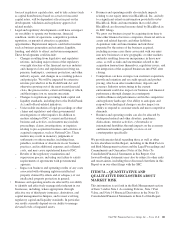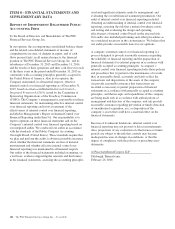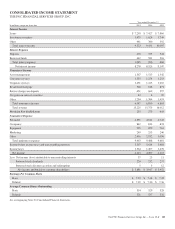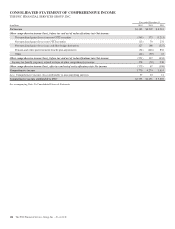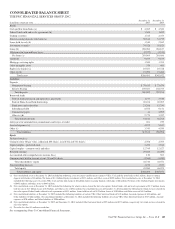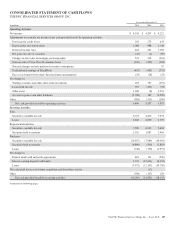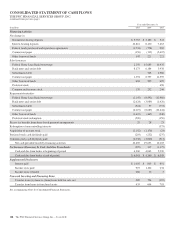PNC Bank 2015 Annual Report Download - page 116
Download and view the complete annual report
Please find page 116 of the 2015 PNC Bank annual report below. You can navigate through the pages in the report by either clicking on the pages listed below, or by using the keyword search tool below to find specific information within the annual report.
exposure, and other factors. Each loan has its own LGD. The
LGD risk rating measures the percentage of exposure of a
specific credit obligation that we expect to lose if default
occurs. LGD is net of recovery, through any means, including
but not limited to the liquidation of collateral or deficiency
judgments rendered from foreclosure or bankruptcy
proceedings.
Net interest margin – Annualized taxable-equivalent net
interest income divided by average earning assets.
Nonaccretable difference – Contractually required payments
receivable on a purchased impaired loan in excess of the cash
flows expected to be collected.
Nonaccrual loans – Loans for which we do not accrue interest
income. Nonaccrual loans include nonperforming loans, in
addition to loans accounted for under fair value option and
loans accounted for as held for sale for which full collection of
contractual principal and/or interest is not probable.
Nondiscretionary client assets under administration – Assets
we hold for our customers/clients in a nondiscretionary,
custodial capacity. We do not include these assets on our
Consolidated Balance Sheet.
Nonperforming assets – Nonperforming assets include
nonperforming loans and OREO and foreclosed assets, but
exclude certain government insured or guaranteed loans for
which we expect to collect substantially all principal and
interest, loans held for sale, loans accounted for under the fair
value option and purchased impaired loans. We do not accrue
interest income on assets classified as nonperforming.
Nonperforming loans – Loans accounted for at amortized cost
for which we do not accrue interest income. Nonperforming
loans include loans to commercial, commercial real estate,
equipment lease financing, home equity, residential real
estate, credit card and other consumer customers as well as
TDRs which have not returned to performing status.
Nonperforming loans exclude certain government insured or
guaranteed loans for which we expect to collect substantially
all principal and interest, loans held for sale, loans accounted
for under the fair value option and purchased impaired loans.
Nonperforming loans exclude purchased impaired loans as we
are currently accreting interest income over the expected life
of the loans.
Notional amount – A number of currency units, shares, or
other units specified in a derivative contract.
Operating leverage – The period to period dollar or percentage
change in total revenue (GAAP basis) less the dollar or
percentage change in noninterest expense. A positive variance
indicates that revenue growth exceeded expense growth (i.e.,
positive operating leverage) while a negative variance implies
expense growth exceeded revenue growth (i.e., negative
operating leverage).
Options – Contracts that grant the purchaser, for a premium
payment, the right, but not the obligation, to either purchase or
sell the associated financial instrument at a set price during a
specified period or at a specified date in the future.
Other real estate owned (OREO) and foreclosed assets –
Assets taken in settlement of troubled loans primarily through
deed-in-lieu of foreclosure or foreclosure. Foreclosed assets
include real and personal property, equity interests in
corporations, partnerships, and limited liability companies.
Excludes certain assets that have a government-guarantee
which are classified as other receivables.
Other-than-temporary impairment (OTTI) – When the fair
value of a security is less than its amortized cost basis, an
assessment is performed to determine whether the impairment
is other-than-temporary. If we intend to sell the security or
more likely than not will be required to sell the security before
recovery of its amortized cost basis less any current-period
credit loss, an other-than-temporary impairment is considered
to have occurred. In such cases, an other-than-temporary
impairment is recognized in earnings equal to the entire
difference between the investment’s amortized cost basis and
its fair value at the balance sheet date. Further, if we do not
expect to recover the entire amortized cost of the security, an
other-than-temporary impairment is considered to have
occurred. However for debt securities, if we do not intend to
sell the security and it is not more likely than not that we will
be required to sell the security before its recovery, the other-
than-temporary loss is separated into (a) the amount
representing the credit loss, and (b) the amount related to all
other factors. The other-than-temporary impairment related to
credit losses is recognized in earnings while the amount
related to all other factors is recognized in other
comprehensive income, net of tax.
Parent company liquidity coverage – Liquid assets divided by
funding obligations within a two year period.
Pretax earnings – Income before income taxes and
noncontrolling interests.
Pretax, pre-provision earnings – Total revenue less noninterest
expense.
Primary client relationship – An Asset Management Group
client relationship with annual revenue generation of $10,000
or more.
Probability of default (PD) – An internal risk rating that
indicates the likelihood that a credit obligor will enter into
default status.
98 The PNC Financial Services Group, Inc. – Form 10-K



